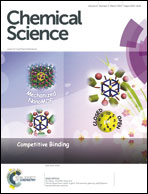MM quadruply bonded complexes supported by vinylbenzoate ligands: synthesis, characterization, photophysical properties and application as synthons†
Abstract
From the reactions between M2(TiPB)4 compounds and meta and para-vinylbenzoic acids (2 equiv.) in toluene at room temperature the compounds trans-M2(TiPB)2L2, where L = m-vinylbenzoate 1A (M = Mo) and 1B (M = W) and TiPB = 2,4,6-triisopropylbenzoate, and where L = p-vinylbenzoate 2A (M = Mo) and 2B (M = W) have been isolated. Compounds 1A and 2A have been shown to undergo Heck carbon–carbon coupling reactions with phenyliodide to produce trans-Mo2(TiPB)2(O2CC6H4-m-CH![[double bond, length as m-dash]](https://www.rsc.org/images/entities/char_e001.gif) CH–C6H5)2, 3A and trans-Mo2(TiPB)2(O2CC6H4-p-CH
CH–C6H5)2, 3A and trans-Mo2(TiPB)2(O2CC6H4-p-CH![[double bond, length as m-dash]](https://www.rsc.org/images/entities/char_e001.gif) CH–C6H5)2, 4A. The molybdenum compounds 1A and 2A have been structurally characterized by single crystal X-ray crystallography. All the new compounds have been characterized by 1H NMR, IR, UV-visible absorption and emission spectroscopy, high resolution MALDI-TOF MS, fs- and ns-transient absorption spectroscopy and fs-time-resolved IR spectroscopy. Electronic structure calculations employing density functional theory, DFT, and time-dependent DFT have been employed to aid in the interpretation of spectral data. All compounds show intense absorptions in the visible region corresponding to M2δ to Lπ* charge transfer transitions. The lifetimes of the 1MLCT state fall in the range of 1–10 ps and for the molybdenum complexes the T1 states are 3δδ* with lifetimes ∼50 μs while for the tungsten complexes the T1 are 3MLCT with lifetimes in the range of 3–10 ns.
CH–C6H5)2, 4A. The molybdenum compounds 1A and 2A have been structurally characterized by single crystal X-ray crystallography. All the new compounds have been characterized by 1H NMR, IR, UV-visible absorption and emission spectroscopy, high resolution MALDI-TOF MS, fs- and ns-transient absorption spectroscopy and fs-time-resolved IR spectroscopy. Electronic structure calculations employing density functional theory, DFT, and time-dependent DFT have been employed to aid in the interpretation of spectral data. All compounds show intense absorptions in the visible region corresponding to M2δ to Lπ* charge transfer transitions. The lifetimes of the 1MLCT state fall in the range of 1–10 ps and for the molybdenum complexes the T1 states are 3δδ* with lifetimes ∼50 μs while for the tungsten complexes the T1 are 3MLCT with lifetimes in the range of 3–10 ns.


 Please wait while we load your content...
Please wait while we load your content...